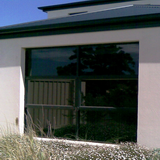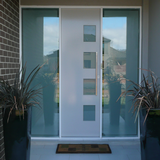No one likes living in a fish bowl. Here we discuss two solutions; how they work and where to use them. This information relates to both residential and commercial windows.
- Daytime, I still want my view
- Privacy day & night, but let the light in
- Day & night privacy, but I still want my view
Daytime, I still want my view


Daytime privacy on external facing windows is achieved by using a sun control film to create a one way effect. These films are made of transparent polyester and may be tinted or metallised or a combination of both. (rule of thumb; tinted means black looking and metallised means shiny)
Every pane of glass is both transparent and reflective to some degree. By increasing the reflectivity or reducing the transparency or both, it can be possible to stop people from seeing in without stopping you from seeing out.
This can be supplemented with some form of curtain or blind for privacy at night. See Links tab in top menu for curtains and blinds.
As you can see from the recommended products below, there is a large choice. However I recommend you get us to help you select a film as it is not easy to pick a film that is dark enough but not too dark just from pictures and the selection will depend on window size, position, room colours and just how much privacy is needed.
Related Articles:
Achieving one way vision on internal windows is much more complex. See these pages for more on this subject.
Recommended products: (from darkest to lightest)
- TruVue 5 - very dark with reflective exterior
- QSQ10 - fairly dark and slightly reflective
- NightSky 10 - fairly dark and non-reflective
- TrueVue 15 - still fairly dark but regularly used for privacy
- Silver 20 - mirrored and regularly used for privacy
- NightSky 20 - regularly used for privacy
- QSQ20 - should work for many situations
- Slate 20 - semi-reflective and regularly used for privacy
In some cases, such as a bedroom with a single window, a medium film will suffice:
Day & night, but let the light in

There are many places where privacy is needed both day and night. The most common ones are at house entrances and bathrooms.
At entrances, curtains frequently pose a problem and are easily damaged when opening and closing doors. Translucent film is a great low maintenance solution and this is also true for bathrooms. Translucent films are available in a number of finishes.
The most popular are:
- 3M Frosted Crystal, which has a sparkling appearance and looks like sandblasted glass.
- 3M Dusted Crystal has a soft appearance which looks like acid etched glass.
- 3M Fasara Milky which has a milky appearance.
For more options see:
Day & night privacy, but I still want my view
Sorry - but it's not possible to be able to see out during the day and yet not have others seeing in at night. This is because the one way privacy effect reverses when the light balance changes. During the day time it is brighter outside by about 100:1 (~70,000 lux to ~700 lux). At night it is darker outside by about 1:100 (< 2 lux to 200 lux). Flood lighting outside to very high levels of around 600 to 1000 lux in a wide area may address this, however it is a very impractical solution because of the cost and probable complaints by neighbours. Unless a frosted film is suitable you will need some form of blind for night time.